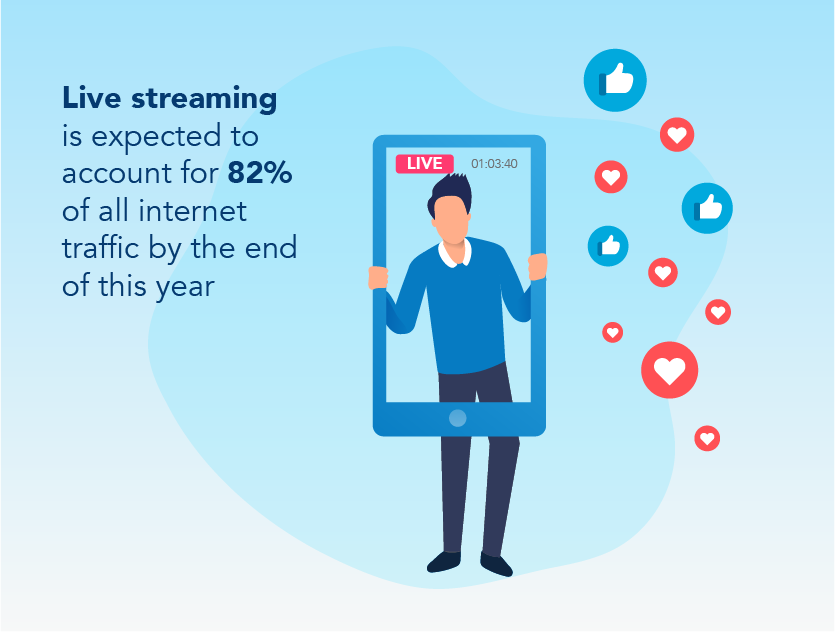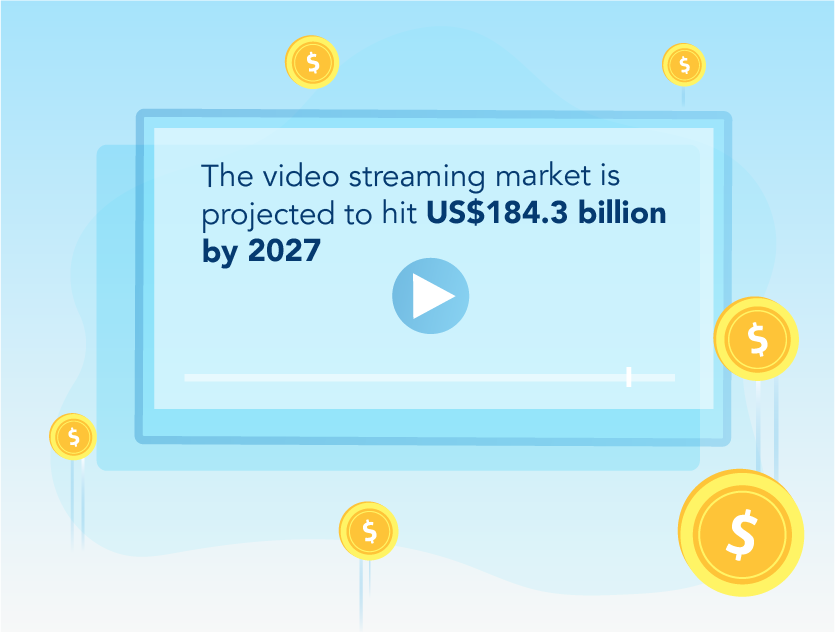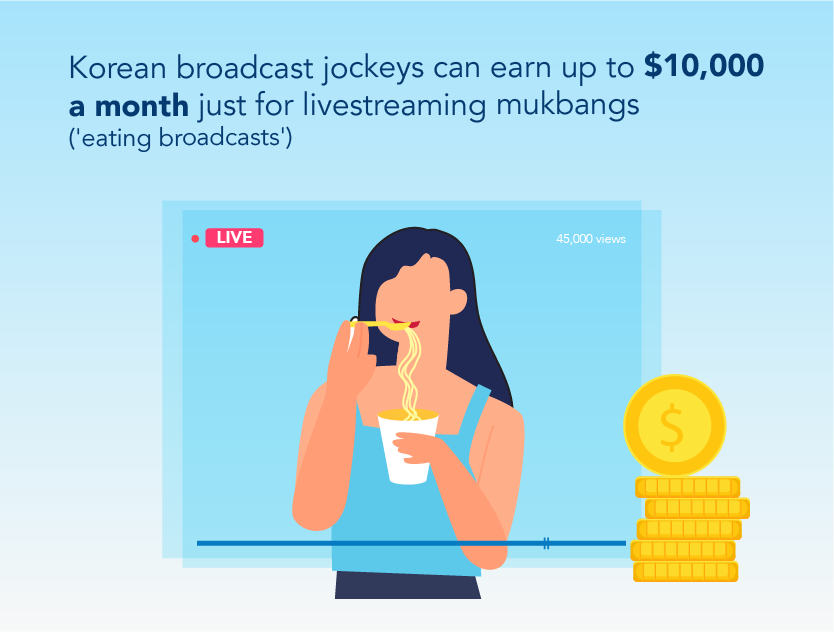

The meteoric rise and reign of livestreaming

Live videos are the hottest trend to take over the digital marketing world in recent years.
Livestreaming has gained immense popularity all over the internet. Everyone from Hollywood celebrities to YouTube stars and regular folk are doing it.
The beauty of today’s extensively connected world means that you can reach people from all continents and timezones in real time with the touch of a button.
When you see the term ‘livestreaming’, it usually refers to broadcast livestreams: from one connection that goes out to multiple users simultaneously.
And no, we’re not talking about your company’s weekly Microsoft Teams’ meetings.
What is livestreaming?

Livestreaming is when the streamed video is sent over the Internet in real time, without first being recorded. How it’s being filmed in real time is exactly what viewers see.
In a world obsessed with filters, edits and perfection, live video is undeniably captivating. After all, anything could happen!
With today’s technology, everything can be live-streamed — television shows, video game streams, college classes or even animals… Yes, you can check out what the penguins over in the Melbourne Zoo are up to at any time of the day.
It doesn’t come as a surprise that live streaming is expected to account for 82% of all internet traffic by the end of this year. But influencers aren’t the only ones who stand to benefit from livestreaming: as it turns out, 82% of people prefer live video from a brand over regular social media posts. So if you’re a brand, you should be trying to give your audience the kind of content that they want.
The main lure of live video is that livestreamers connect and engage with their audience just like how they do in real life, but without geographical constraints.
Someone in the United States could go live at this moment, and a viewer all the way in Japan can tune in to ask a question and have it answered in real time. It’s almost as if they aren’t separated by the entire Pacific Ocean.
The rise of live video
Twitch, Instagram Live, Linkedin Live, Periscope, Bigo Live… Welcome to the constantly evolving age of live video.
It’s a no brainer that social media is a big driver of this livestreaming trend: the video streaming market is projected to hit US$184.3 billion by 2027.
A once-unimaginable feat, there are actually numerous content creators today who are able to make a living just by going live. Apart from the typical chats and #AskMeAnything, livestreaming has even expanded into e-commerce: China’s e-commerce livestream queen Viya earned an estimated 30 million yuan in 2018.
In other areas, gaming and eSports livestreams have been breaking viewership records. On average, 1.05 million viewers were on Twitch at any given time in 2019 Q4.
Earlier this year, in the midst of lockdown, places of religious worship also hopped onto the practice of livestreaming their services, connecting people through prayer across the web.
But the concept of live broadcasts have been around for a long, long time. Remember Live Aid back in 1985, anyone? Well, Freddie’s vocals weren’t the only thing that were impressive — the whole concert was broadcasted by international satellite links, and watched by approximately 1.9 billion viewers in 150 countries.
Fast forward to 2020, all you need is a smartphone and a social media account and you’re set to be the next livestreaming sensation.
Using live videos to communicate with one another is seen as a legitimate form of connection in a digital world. However foreign this idea might have seemed a decade ago, it’s almost second-nature now.
While the previous generations might have cringed at the unfiltered nature of an unplanned live video, the world is much more understanding and appreciative of this genuineness that comes across in live media.
An outlet for innovation
With livestreaming, the possibilities are endless. As the guys over at YouTube would tell you — people watch anything and everything, especially if it’s live. In May 2019, viewers watched YouTube Live videos for a jawdropping total of 284 million hours — a monthly record for the video platform.
The most-viewed livestreaming event in YouTube’s history still remains the 2012 space jump by skydiver Felix Baumgartner, watched live by more than eight million people simultaneously. Please don’t hurl yourself off a building or attempt dangerous acts for some clicks, likes and views during your livestream, although there are people who do.
Music performances and concerts are also popular livestream content — Andrea Bocelli’s Easter Sunday performance made him YouTube’s newest superstar. His Music For Hope — Live From Duomo di Milano reached over 2.8 million peak concurrent viewers, making it one of the biggest musical livestream performances of all time, according to the platform.
If you’re not quite about classical music, how about a rave instead? As clubs and parties continue to be a major no-no due to social distancing concerns, DJs all over the world have taken to the internet to livestream their sets to partygoers stuck at home. Without a cure or vaccine in sight, this looks to be a much-safer alternative to real-life events, at least in the foreseeable future. It means you don’t have to cancel your events anymore!
And if we’re talking about livestreaming, how can we miss out mukbangs? Originating from South Korea, mukbangs are livestream eating shows that are extremely popular in Asia. In Korea alone, during dinnertime hours, 45,000 viewers tune in to watch mukbangs at the same time.
They’re not just regular eating shows though; a key feature of mukbangs is the massive amount of food being consumed by the livestreamer (often referred to as Broadcast Jockeys, or BJs). And we really mean massive: in a single sitting, some of these BJs consume enough food to feed a whole family of five.
As wild or as foreign as this might seem, it is indeed possible to make a living and even become rich just by eating — some popular mukbang BJs can earn up to $10,000 a month! Who would have thought? A new era is truly upon us.
Best practices for live video
Thinking of livestreaming? Make sure to keep the following things in mind:
Check your setup!
Nothing irritates viewers more than low-quality footage: 90 seconds seems to be the longest a viewer would tolerate a spotty stream. As such, the most important equipment of your livestreaming setup is your camera. Yes, your computer likely already has one built-in, but it’s really not of the best quality.
Try using your smartphone instead and opt for the back camera. Depending on the type of content you’re going for, whether it’s something more spontaneous or if you’re streaming to a professional audience, you can consider having it on a tripod. You may think you have steady hands, but they’ll never be as steady as a tripod.
While you’re at it, for clearer audio quality, consider using earphones rather than relying on the built-in speakers. Even your Airpods would work better!
Lastly, ensure you’re seated in an area that is well-lit, avoiding direct overhead lighting to prevent any shadows on your face.
If you’re hosting a livestream for your brand, try hosting it in your office. This would give your existing customers as well as potential clients a peek into your workspace and even bring them behind-the-scenes. It definitely makes you look more professional compared to presenting from your bedroom.
Generate hype
You might think that the spontaneity of going live out of the blue is the whole point of livestreaming, and you’re really not wrong. But unless you’re a Hollywood celebrity, you’re not likely to garner that much of a viewership.
You’ll therefore need to let your audience know when you’re going live way before you actually do. This is so your audience gets enough time to clear their schedules and set a reminder.
You also get a small window of time to promote your upcoming livestream on various social media handles and your own website or landing page — all of which would eventually help boost your viewership.
The same goes for B2B marketing. Promote your brand’s livestream by announcing your hosts and providing some background info on their expertise as well as the topic they’ll be talking about.
Remember to hashtag relevant keywords onto your posts as this helps to entice even more potential viewers who might not be following your brand, but who are following these hashtags.
Streaming duration
There really is no hard and fast rule for how long your streams should be. After all, mukbangs can sometimes last up to three hours long! But in general, both Facebook and LinkedIn suggest that you should go live for at least 10-15 minutes.
The idea here is that you need to give your followers some time to join the stream, and your viewership ratings will likely build the longer you stream.
But bear in mind, your content needs to be sufficiently engaging if you plan to continue streaming for long stretches of time. If you can’t capture your audience’s attention sufficiently, they are always going to drop off.
Interact with your audience
…because that IS the whole point of holding a livestream, isn’t it?
As more and more people tune in, say hello to new viewers, and try to incorporate a Q&A segment as well. The beauty of this is that it can go both ways: you can either ask a question and let your viewers respond in the chat, or answer questions that your viewers ask in the chat.
In the B2B space, audience interactivity can make all the difference when it comes to building brand trust. Answering customer inquiries in real-time leaves little room for companies to follow a script — forcing the livestreaming hosts to think on their feet. This also means that the answers offered are just about as authentic as they can be.
Taking interactivity up another notch, certain platforms like Instagram Live also let you add another user into your ongoing livestream — meaning you get to livestream together. And from anywhere in the world.
But the best part about going live with a friend — or a business partner — is the exposure you gain for you and your brand to a wider audience. In such a live session, both of your profile icons will be stacked on top of each other in the stories bar; all your followers — and theirs too — will see that and more people may become aware of your brand.
Instagram Lives can also be saved and repurposed for upload onto other networks so that your followers who missed it can still watch the videos.
Finally, if this is your first foray into livestreaming, perhaps having someone co-host is less intimidating compared to hosting solo, since you can bounce comments off of each other.
Consider creating series-based content
A quick way to build a stable viewership base? Consider creating series-based content.
Firstly, this helps create a consistent hype around your livestream. Viewers will continuously anticipate the next instalment in your series once they know that there’s always going to be more content that you’re sharing.
By consistently going live on a regular basis, be it daily, weekly or even monthly, your audience will also learn to tune in to your stream at a specific time. You actually save time on promoting and marketing every time you decide to go live.
The allure of live video is undeniable, especially in a world pulled farther apart from each other due to social distancing. Once a heavy duty affair, now anyone and everyone can start live streaming just with their smartphones. It’s time for you to give it a shot!
Want to start livestreaming your next event on the web? Let us help. Contact our lead producer Alex at [email protected]
Read more from Click2View:
- Here’s why email marketing still matters.
- Read about what we learnt from producing our own newsletter.
- Ever wanted to know the key to writing a successful blog post?
Sign up to our newsletter for a weekly update on the latest content marketing news. Don’t forget to subscribe to our YouTube channel too!
Click2View is Southeast Asia’s premiere full-service independent B2B content marketing agency servicing clients like Microsoft, Google, Visa, Prudential, and the Lee Kuan Yew School of Public Policy.










